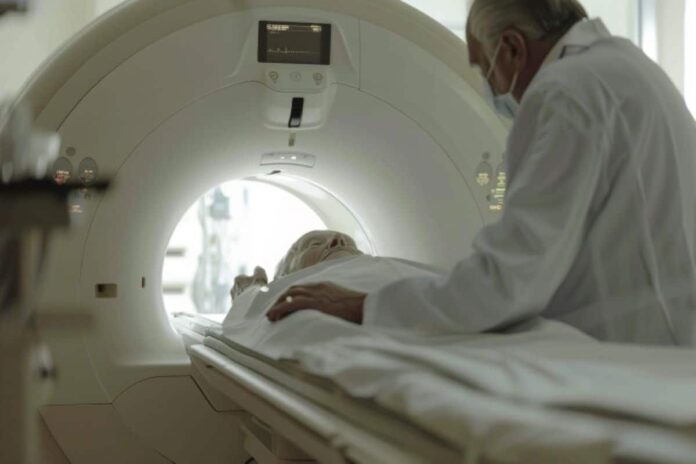- A new machine learning model can predict the eventual occurrence of dementia, according to a new study.
- Its authors say the model is greater than 80% accurate and can predict disease up to nine years early.
- The study focused on all-cause dementia, as well as risk factors for Alzheimer’s disease, the most common type of dementia.
A new test can predict dementia with 82% accuracy, according to researchers at Queen Mary University of London in the U.K.
Analyzing 1,111 functional magnetic resonance imaging (fMRI) scans of people with and without dementia, the researchers produced a model using machine learning. They say it spots the telltale signs of dementia up to nine years before diagnosis.
The model identifies changes in the brain’s default mode network (DMN)Trusted Source. The DMN is active when a person is lying in an fMRI scanner, not doing anything. The DMN state is believed to play a role in daydreaming and introspection, among other activities. It is more active when a person is at rest or engaged in self-referential thought.
The researchers collected the fMRI scans used in the study from the UK Biobank. The participants included 81 people who had not been diagnosed with dementia at the time their scans were taken, but who developed the condition up to nine years afterward. For comparison, 1,030 people served as matched controls for the study.
The researchers examined disconnects between 10 key regions within the DMN, using machine learning to construct their model.
When they applied their model to medical records of the participants, they found it accurately predicted dementia within a two-year window during which is when such a diagnosis would occur.
The authors of the study also looked for associations between DMN disconnectivity and various dementia risk factors. They found links between the model and social isolation — which has been linked to the likelihood of developing Alzheimer’s disease — as well as a genetic risk for the condition.
The hope is that early detection may one day provide a chance for early interventions that may forestall or prevent dementia.
Diagnosing different types of dementias
Dr. Claire Sexton, DPhil, the Alzheimer’s Association’s U.S. senior director of scientific programs and outreach, who was not involved in the study, said the DMN seems to be implicated in Alzheimer’s.
“A number of studies,” she said, “have found that Alzheimer’s is associated with decreased functional connectivity within the DMN.”
“This is congruent with our current knowledge of Alzheimer’s, with other characteristic brain changes known to begin years, even decades, prior to diagnosis,” said Sexton.
The predictive tool is aimed at detecting all-cause dementia, not just Alzheimer’s, and dementias can be quite different, pointed out Clifford Segil, DO, neurologist at Providence Saint John’s Health Center in Santa Monica, CA. (He was likewise not involved in the study.)
Segil explained that Alzheimer’s is a “cortical dementia with damage to the cortex of the brain, and there is vascular dementia, which is a subcortical dementia that involves damage to the white matter of the brain.”
Still, pointed out the senior author of the study, Professor Charles Marshall, clinical senior lecturer in dementia in the Preventive Neurology Unit at Queen Mary, “In practice, a large majority of dementia is due to either Alzheimer’s disease on its own or mixed Alzheimer’s and vascular dementia.”
“We need to extend the work to show whether or not it is relevant to rarer dementias such as frontotemporal dementia and Lewy body dementiaTrusted Source,” Marshall told Medical News Today.
Seeking a pattern in the brain
The model developed by Marshall’s team tracked various sorts of activity.
“Some brain areas show reduced activity, but others show increased activity, probably as a compensatory response. We trained a machine learning tool to recognize patterns that were ‘dementia-like,’” said Marshall.
A practical predictive model for diagnosing dementia
In general, Segil was supportive of the continued development of new models for diagnosing cognitive problems before they manifest as symptoms, particularly in the DMN.
He pointed out, however, that “one of the issues with using fMRI, similar to nuclear medicine studies used in neurology, is the reproducibility of reading these studies.”
“For example,” explained Segil, “neurologists and neuro-radiologists often see the same findings when they look at structural 3T MRITrusted Source scans, but fMRIs, unfortunately in clinical practice, have different readers arrive at completely different conclusions at this time.”
Sexton listed three limitations she found with the current study:
- “the definition and examination of DMN disconnectivity varies substantially across studies
- the current study reports all-cause dementia based on clinician coding rather than on diagnostic criteria
- the cohort from which this study was drawn, UK Biobank, is predominantly white, healthier than average, with a higher than average socioeconomic status.”
These factors, she said, limit the generalizability of the study’s findings.
“Replication of results with standardized methods and in study populations that accurately represent the population living with, and at risk of, Alzheimer’s is crucial,” said Sexton.
No protective dementia medications — yet
Early detection of cognitive issues is one vital part of helping patients, with effective treatments being the other.
“If these tests pan out to have some clinical utility in the future,” said Segil, “these patients would be followed by more frequent 3T structural MRI scans to determine if there were anatomical changes that would correlate with their memory loss.”
“Unfortunately, in the year 2024, even if we could target patients with early onset dementia, we do not have any neuroprotective medications to be used at this time,” Segil said.
Marshall said that as such interventions are eventually developed, he hoped that “our test could be used to select the most appropriate people to go into these trials.”





